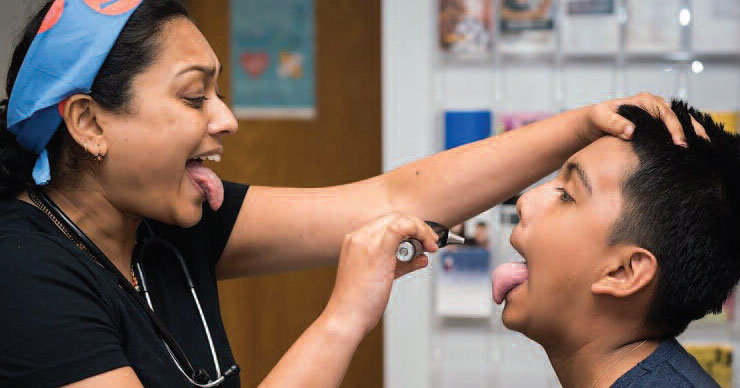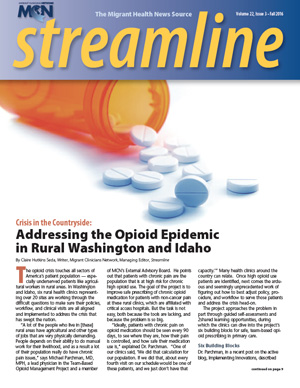A Clinician’s Guide to Burnout and Balance

By Claire Hutkins Seda, Writer, Migrant Clinicians Network, Managing Editor, Streamline
Burnout, in which a worker is physically and emotionally exhausted from too much difficult work, is often associated with the medical field. Almost every clinician knows someone in the office who has experienced the serious and debilitating condition. A 2014 Mayo Clinic survey uncovered that burnout increased between 2011 and 2014, with now over 50 percent of physicians experiencing at least one symptom of burnout. With increasing patient loads, fewer clinicians choosing primary care nationwide, and growing demands on clinicians like electronic health record utilization, the increase in burnout is a concern that can alter a clinician’s life and cause conditions like depression. For patients, it jeopardizes high-quality, compassionate health care delivery around the country.
Burnt-out physicians feel a high degree of cynicism, or “depersonalization” toward their patients, viewing them more like objects than human beings; burnout may also increase medical errors. Overly stressed work environments negatively affect others in the office, too, creating a culture of burnout. Clinicians serving migrant and seasonal agricultural workers and other underserved populations may experience greater levels of frustration and hopelessness as a result of their patients’ health situation. Agricultural workers – because of their frequent mobility, their often tenuous financial situation, and concerns about missing work, among other barriers – may struggle to get to the clinic. When they do, they may have a backlog of health concerns that cannot all be addressed in the short window of time with the clinician. “We try to adjust treatment modalities to take into account the realities of their lives – but it can be very stressful” for clinicians, admitted Karen Mountain, RN, MSN, MBA, Chief Executive Officer for Migrant Clinicians Network. A clinician may “know what the patients need, but…be unable to assure that they can get it,” a frustrating and disheartening experience for many clinicians, said Mountain, yet another contributor to burnout.
The work-life balance — in which a clinician ensures enough down-time to decompress, take care of personal needs, and come back sufficiently refreshed and ready to work every morning — is an essential measure to prevent or lessen burnout. How does one achieve a balance, within work and outside of work, to prevent burnout?
“Wellness is about finding balance, but it means something different to each person,” said Ben Morrison, MD, Chief Medical Officer at Community Medical Centers, Inc, a Federally Qualified Health Center in the northern reaches of the San Joaquin Valley, California. He is seeking to address clinician burnout at his health center. “Some of it has to do with work ethic, where [clinicians] are in life. I think our goals change as we go through life….There’s no set formula.”
But there are parameters one can assess. Clinicians can regularly reevaluate their personal work-life balance, which changes as life progresses. Health center administration can take steps to relieve the pressure on clinicians while they are at work. And clinicians and administrative officials together can create a work atmosphere that values balance and strives to help clinicians find it.
Changes throughout the stages of life
Many clinicians coming out of medical school recognize the stress that is ahead of them. After many years of higher education, they willingly sign up for an often grueling residency. “We’re prepared for residency — you’re prepared to work the long, hard hours,” Dr. Morrison remarked. When a clinician finally ends residency, though, “then life starts to happen.” Clinicians may have greater control over work pressures, but simultaneously many of these younger clinicians begin to have life events that require greater attention.
When a clinician is pregnant or has a young child at home, or when a personal relationship ends, or when parents need to be cared for, daily priorities and motivations shift. “[Modern clinicians] have it correct: We want it all. We don’t mind working hard, but we want to be able to enjoy these experiences,” outside of work life, Dr. Morrison says.
Dr. Morrison reminds clinicians to regularly evaluate their work-life balance as both work and life shift. As a clinician enters a new phase of life, his or her needs and responsibilities outside of work may change — and few clinicians account for this in their work life. Anticipating personal life changes can help buffer the stress of a big change at work — and vice-versa.
The simple stress of the job
The work-life balance can be difficult for those who spend their entire careers serving people with significant and overlapping health issues, but it may be amplified for clinicians serving the underserved. Underserved patients often come with stories of dire poverty, homelessness, trauma, and other serious struggles, all of which affect the health of the patient. A 2012 Walter Reed study found that clinicians who spent time every week at an on-site complementary and alternative medicine wellness clinic not only reported feeling more relaxed after sessions (97.9%) and feeling less stressed (94.5%), and experiencing less pain (78.8%), but, after five or more visits, more than half of respondents strongly agreed on their surveys that they experienced increased compassion with patients. Lead author on the study, Alaine Duncan, L.Ac, a Marylandbased licensed acupuncturist who focuses on trauma in her patients, believes the work-life balance message is clear: self-care is essential in the face of trauma.
“Clinicians may experience burnout as a sense of overwhelm with the suffering of the world, and not knowing what to do with it,” Duncan said. Day-in and day-out experiences with traumatized or suffering patients may weigh heavily on clinicians. Recognizing this additional burden and scheduling in time to recuperate and process is essential when dealing regularly with trauma.
Additionally, a clinician’s reaction to the patient is critical to avoid burnout. “We lose our witness state,” she said, “and we fall into their stories.” Duncan encourages clinicians to seek education on trauma resolution to best focus on resiliency of patients and “to treat the patient’s dysregulation — not the [patient’s] story.”
Changes in the health world, too
“I don’t think medicine has gotten harder,” Dr. Morrison states, but the world of medicine has significantly changed in the last fifty years, which presents new challenges to clinicians. Take the national rollout of the electronic health record. While some clinicians are relieved to have gotten over the initial learning curve, others still struggle. Either way, many clinicians were frustrated when new systems disrupted workflows and required cumbersome and at times repetitive electronic entries. While all clinicians recognize the many important benefits that patients and health centers will gain as a result of the EHR, productivity went down throughout the country. In recent years, after the initiation of the Affordable Care Act, a new influx of patients has created provider shortages. Such system-wide struggles place undue burden on clinicians and need to be addressed throughout the country.
Just as clinicians can anticipate home life shifts that will change the work-life balance, health center administrators can account for new shifts at the workplace. Such big stressors like clinician shortages and the drop in efficiency related to the EHR can’t be fixed easily, but administrators can make concrete steps to lessen the blow.
Mountain says that when she visits health centers around the county, she doesn’t see the burnout — she sees the wreckage. “When you see people who feel valued, that just comes across. When you see leaders who are insensitive, who are projecting the needs of the corporation over the needs of the employee… there’s resentment, and anger, or just flatness,” among the employees, Mountain said. “And that just carries right down to the patients.”
Dr. Morrison recommends that administration address the work-life balance at the organizational and individual level. At the organizational level, “having a provider advocate is important,” Dr. Morrison emphasized, to keep clinician needs at the table during executive decision making. A provider advocate can guarantee that big decisions aren’t made without the work-life balance in mind.
Equally essential is the support team. “We’re trying to develop our work teams to better support the provider,” Dr. Morrison noted. Better coordination of the provider’s team reduces the burden on the provider and assures that all clinicians are working at the top of their profession. “We also are reevaluating our compensation models,” Dr. Morrison said, looking into how the schedule is built, and attempting to find flexibility in the schedule for those who need it.
On the individual level, Dr. Morrison has taken the extra step of reaching out to each clinician to meet one-on-one. A CMO cannot discover what the clinicians need unless you directly ask, he says. “I will bring a provider to lunch, find out what’s going on with them. Sometimes everything is going great and we just talk about their families... but I’m letting the providers know that I really care about them,” he said. “I want to be proactive... What are their needs? Are there things that we could be doing better for them?” Additionally, the one-on-one time helps Dr. Morrison get a wider perspective, hearing from busy or quiet clinicians he may otherwise not hear from: “We want everyone to have a say on things that are going on and not implement policies without getting their input.”
"As a clinician enters a new phase of life, his or her needs and responsibilities outside of work may change — and few clinicians account for this in their work life."
One final individual-level adjustment that Dr. Morrison recommends is assuring that the executive team is modeling the work-life balance that they want to see in the clinicians. An overworked, burnt-out administration cannot address the burnout issues of their staff. “Initially, I thought the harder I work, the more I’m supporting my providers,” Dr. Morrison noted. “But it sends the wrong message.” He admits that he enjoys his job and isn’t opposed to working long hours, but he has set up his own personal barriers that he will not cross, to assure that he maintains his own work-life balance.
Mountain agrees: “It’s not just the clinicians, it’s everybody” who can experience burnout. She recounts a recent visit with a health center during which the vice president of operations took the time to help a patient navigate a new building. “That to me spoke volumes of the values of the leadership — the fact that there’s somebody who is mission-driven and caring. When you’re burned out, you lose touch with caring about others — because you haven’t been able to care for yourself.”
Finding compromise
Dr. Morrison cautions that not all rebalancing attempts will be successful. If a clinician is seeking part-time work only in the middle of the day for a few days a week, health center administration may not be able to accommodate that. “We have patient needs — we have evening and Saturday clinics — so we need to set realistic expectations. But communication is absolutely important,” he stated. “Ultimately, as a provider, we have to work very hard. But it doesn’t mean we have to suffer because of it, and not have any balance. We have to have a team approach — because no one can create the balance for you, but you have to have people who are willing to listen and acknowledge that that balance is important.”
Dr. Morrison believes his approach is working. A couple of clinicians who left his health center have returned, which he thinks is a good sign for the work environment he’s set up. But he recognizes it’s an ongoing, lifelong process: “We’re not a perfect system, but I definitely think we’re heading in the right direction and we’re listening to our providers.”
Read this article in the Fall 2016 issue of Streamline here!
Sign up for our eNewsletter to receive bimonthly news from MCN, including announcements of the next Streamline.
Return to the Streamline Fall 2016 Table of Contents.
